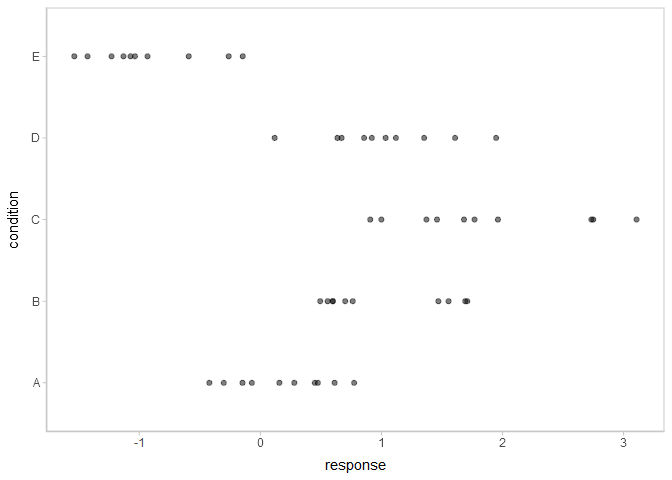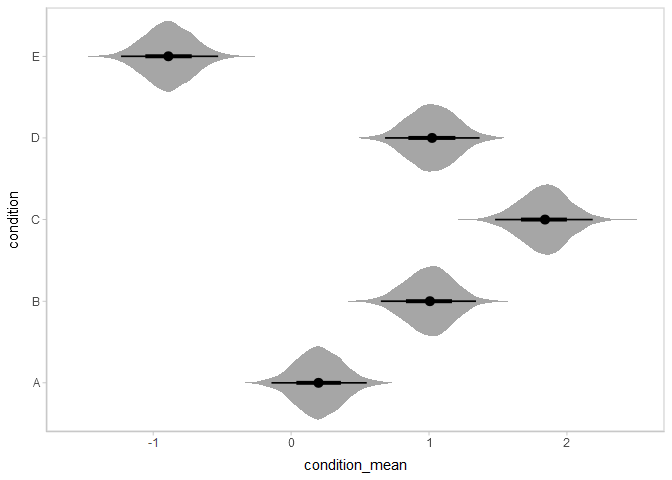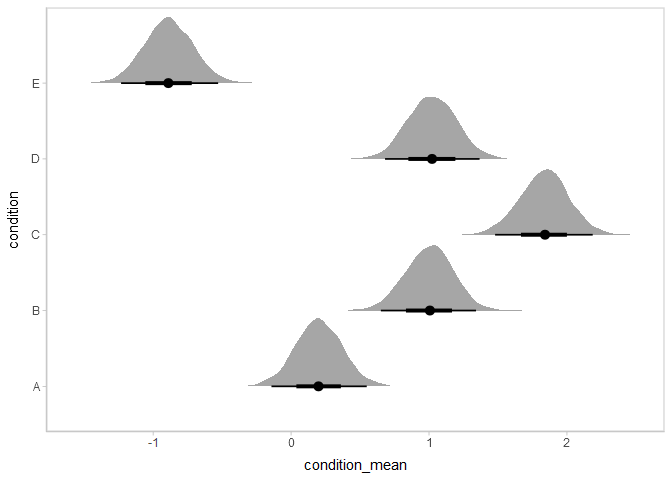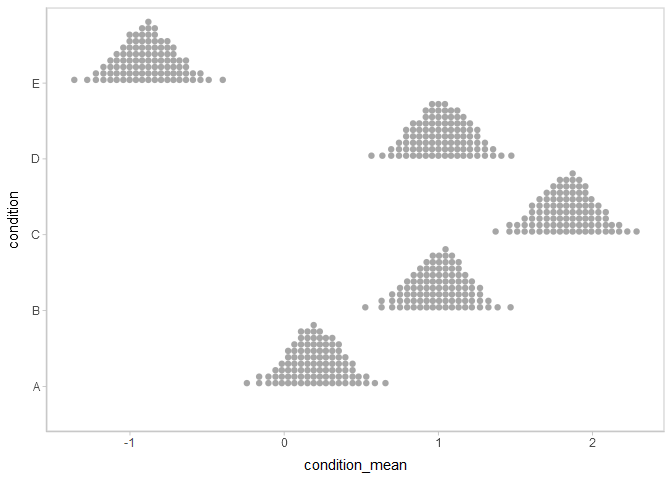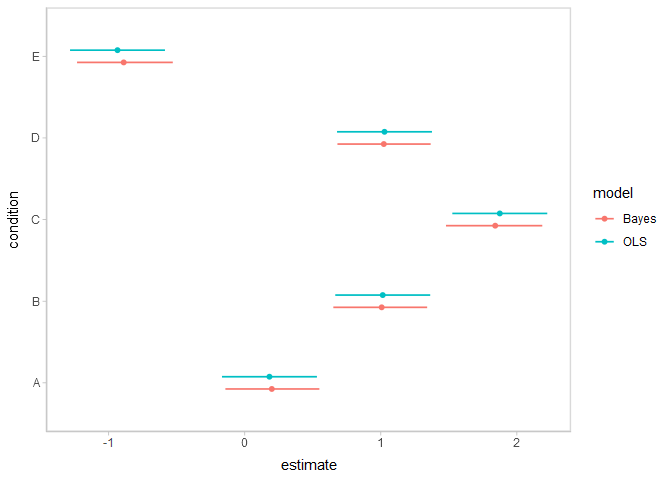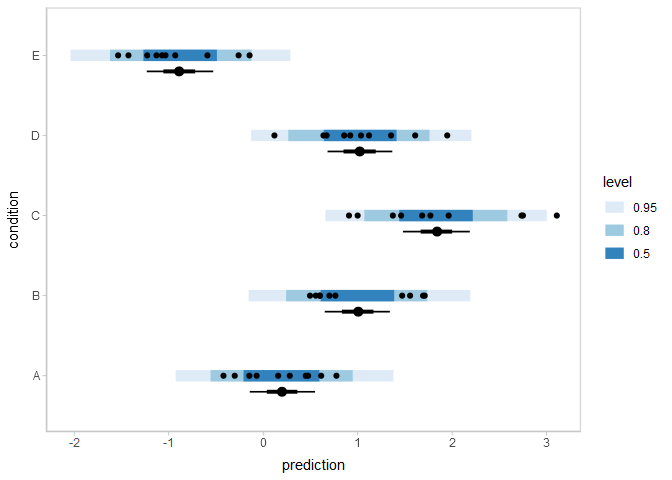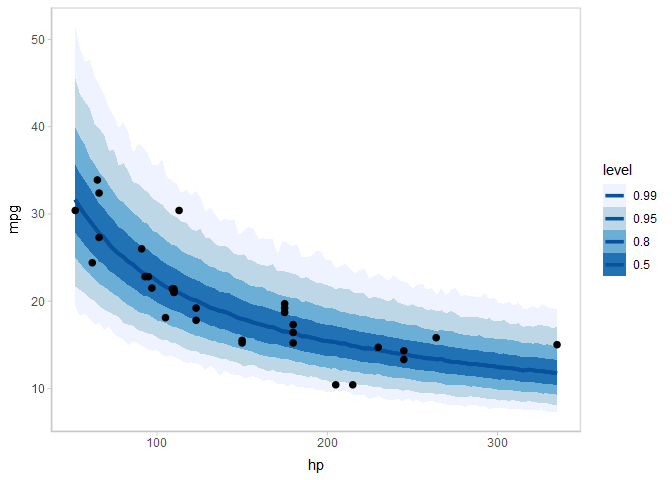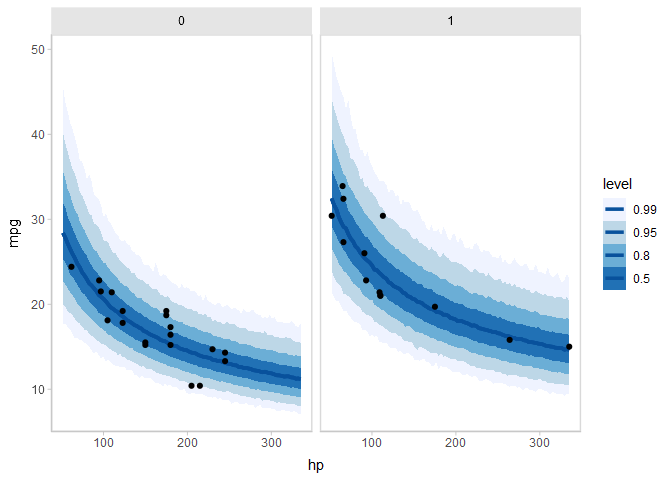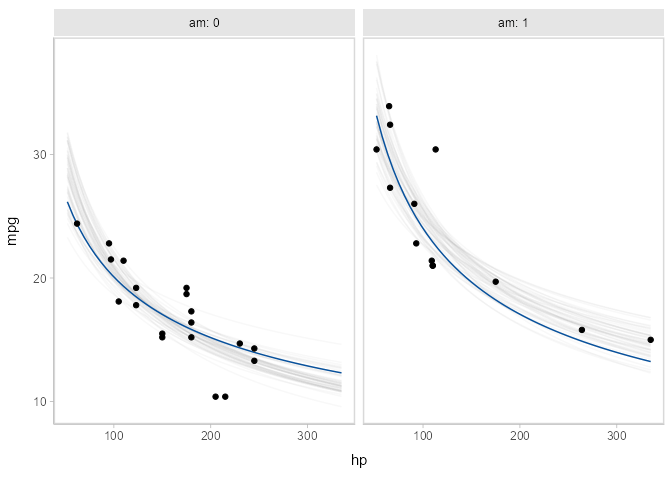tidybayes is an R package that aims to make it easy to integrate popular Bayesian modeling methods into a tidy data + ggplot workflow. It builds on top of (and re-exports) several functions for visualizing uncertainty from its sister package, ggdist
Tidy data frames (one
observation per row) are particularly convenient for use in a variety of
R data manipulation and visualization packages. However, when using
Bayesian modeling functions like JAGS or Stan in R, we often have to
translate this data into a form the model understands, and then after
running the model, translate the resulting sample (or predictions) into
a more tidy format for use with other R functions. tidybayes aims to
simplify these two common (often tedious) operations:
-
Composing data for use with the model. This often means translating data from a
data.frameinto alist, making surefactorsare encoded as numerical data, adding variables to store the length of indices, etc. This package helps automate these operations using thecompose_data()function, which automatically handles data types likenumeric,logical,factor, andordinal, and allows easy extensions for converting other data types into a format the model understands by providing your own implementation of the genericas_data_list(). -
Extracting tidy draws from the model. This often means extracting indices from parameters with names like
"b[1,1]","b[1,2]"into separate columns of a data frame, likei = c(1,1,..)andj = c(1,2,...). More tediously, sometimes these indices actually correspond to levels of a factor in the original data; e.g."x[1]"might correspond to a value ofxfor the first level of some factor. We provide several straightforward ways to convert draws from a variable with indices into useful long-format (“tidy”) data frames, with automatic back-conversion of common data types (factors, logicals) using thespread_draws()andgather_draws()functions, including automatic recovery of factor levels corresponding to variable indices. In most cases this kind of long-format data is much easier to use with other data-manipulation and plotting packages (e.g.,dplyr,tidyr,ggplot2) than the format provided by default from the model. Seevignette("tidybayes")for examples.
tidybayes also provides some additional functionality for data
manipulation and visualization tasks common to many models:
-
Extracting tidy fits and predictions from models. For models like those provided by
rstanarmandbrms,tidybayesprovides a tidy analog of theposterior_epred(),posterior_predict(), andposterior_linpred()functions, calledadd_epred_draws(),add_predicted_draws(), andadd_linpred_draws(). These functions are modeled after themodelr::add_predictions()function, and turn a grid of predictions into a long-format data frame of draws from either the fits or predictions from a model. These functions make it straightforward to generate arbitrary fit lines from a model. Seevignette("tidy-brms")orvignette("tidy-rstanarm")for examples. -
Summarizing posterior distributions from models.
tidybayesre-exports theggdist::point_interval()family of functions (median_qi(),mean_qi(),mode_hdi(), etc), which are methods for generating point summaries and intervals that are designed with tidy workflows in mind. They can generate point summaries plus an arbitrary number of probability intervals from tidy data frames of draws, they return tidy data frames, and they respect data frame groups.tidybayesalso provides and implementation ofposterior::summarise_draws()for use with grouped data frames, such as those returned by thetidybayes::XXX_drawsfunctions. -
Visualizing priors and posteriors. The focus on tidy data makes the output from tidybayes easy to visualize using
ggplot. While existinggeoms (likeggdist::geom_pointrange()andggdist::geom_linerange()) can give useful output, the output fromtidybayesis designed to work well with several geoms and stats in its sister package,ggdist. These geoms have sensible defaults suitable for visualizing posterior point summaries and intervals (ggdist::geom_pointinterval(),ggdist::stat_pointinterval()), visualizing distributions with point summaries and intervals (theggdist::stat_sample_slabinterval()family of stats, including eye plots, half-eye plots, CCDF bar plots, gradient plots, dotplots, and histograms), and visualizing fit lines with an arbitrary number of uncertainty bands (ggdist::geom_lineribbon()andggdist::stat_lineribbon()). Priors can also be visualized in the same way using theggdist::stat_slabinterval()family of stats. Theggdist::geom_dotsinterval()family also automatically finds good binning parameters for dotplots, and can be used to easily construct quantile dotplots of posteriors (see example in this document). For convenience,tidybayesre-exports theggdiststats and geoms.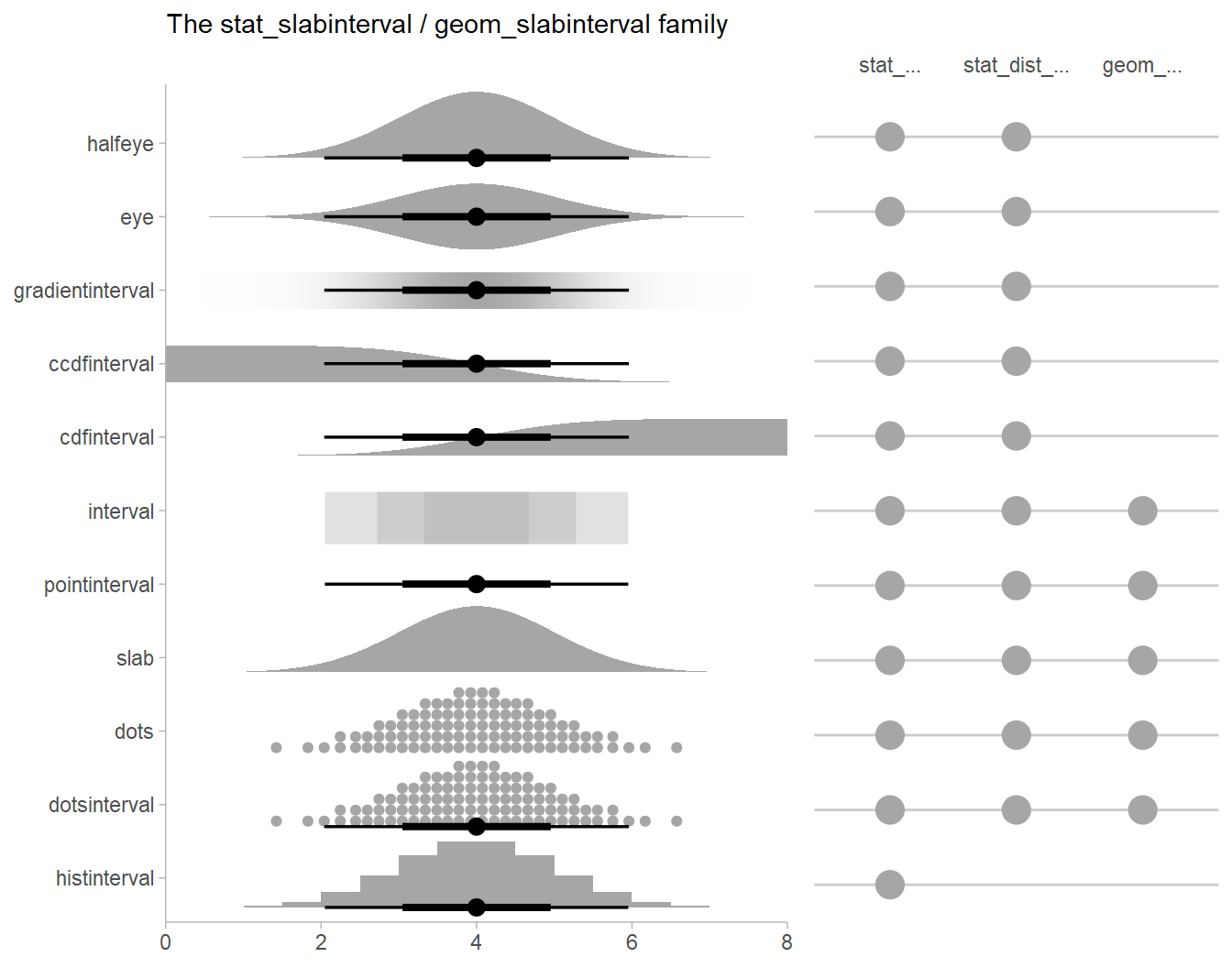 The slabinterval family of geoms and
stats
The slabinterval family of geoms and
stats
See
vignette("slabinterval", package = "ggdist")for more information. -
Extracting and visualizing data frames of random variables from models.
tidybayesalso providesXXX_rvarsfunctions as alternatives to theXXX_drawsfunctions, such asspread_rvars(),add_predicted_rvars(), etc. These functions instead return tidy data frames ofposterior::rvar()s, a vectorized random variable data type (seevignette("rvar", package = "posterior")for more aboutrvars). Combined with theggdist::stat_slabinterval()andggdist::stat_lineribbon()geometries, these functions make it easy to extract samples from distributions, manipulate them, and visualize them; this format may have significant advantages in terms of memory required for large models. Seevignette("tidy-posterior")for examples. -
Comparing a variable across levels of a factor, which often means first generating pairs of levels of a factor (according to some desired set of comparisons) and then computing a function over the value of the comparison variable for those pairs of levels. Assuming your data is in the format returned by
spread_draws, thecompare_levelsfunction allows comparison across levels to be made easily.
Finally, tidybayes aims to fit into common workflows through
compatibility with other packages:
-
Its core functions for returning tidy data frames of draws are built on top of
posterior::as_draws_df(). -
Drop-in functions to translate tidy column names used by
tidybayesto/from names used by other common packages and functions, including column names used byggmcmc::ggs(viato_ggmcmc_namesandfrom_ggmcmc_names) and column names used bybroom::tidy(viato_broom_namesandfrom_broom_names), which makes comparison with results of other models straightforward. -
The
unspread_drawsandungather_drawsfunctions invertspread_drawsandgather_draws, aiding compatibility with other Bayesian plotting packages (notablybayesplot). -
The
gather_emmeans_drawsfunction turns the output fromemmeans::emmeans(formerlylsmeans) into long-format data frames (when applied to supported model types, likeMCMCglmmandrstanarmmodels).
tidybayes aims to support a variety of models with a uniform
interface. Currently supported models include
rstan,
cmdstanr,
brms,
rstanarm,
runjags,
rjags,
jagsUI, coda::mcmc and
coda::mcmc.list,
posterior::draws,
MCMCglmm, and anything
with its own as.mcmc.list implementation. If you install the
tidybayes.rethinking
package, models from the
rethinking package are also
supported.
You can install the currently-released version from CRAN with this R command:
install.packages("tidybayes")Alternatively, you can install the latest development version from GitHub with these R commands:
install.packages("devtools")
devtools::install_github("mjskay/tidybayes")This example shows the use of tidybayes with the Stan modeling language;
however, tidybayes supports many other model types, such as JAGS, brm,
rstanarm, and (theoretically) any model type supported by
coda::as.mcmc.list.
library(magrittr)
library(dplyr)
library(ggplot2)
library(rstan)
library(tidybayes)
library(emmeans)
library(broom)
library(brms)
library(modelr)
library(forcats)
library(cowplot)
library(RColorBrewer)
library(gganimate)
theme_set(theme_tidybayes() + panel_border())Imagine this dataset:
set.seed(5)
n = 10
n_condition = 5
ABC =
tibble(
condition = factor(rep(c("A","B","C","D","E"), n)),
response = rnorm(n * 5, c(0,1,2,1,-1), 0.5)
)
ABC %>%
ggplot(aes(x = response, y = condition)) +
geom_point(alpha = 0.5) +
ylab("condition")A hierarchical model of this data might fit an overall mean across the
conditions (overall_mean), the standard deviation of the condition
means (condition_mean_sd), the mean within each condition
(condition_mean[condition]) and the standard deviation of the
responses given a condition mean (response_sd):
data {
int<lower=1> n;
int<lower=1> n_condition;
int<lower=1, upper=n_condition> condition[n];
real response[n];
}
parameters {
real overall_mean;
vector[n_condition] condition_zoffset;
real<lower=0> response_sd;
real<lower=0> condition_mean_sd;
}
transformed parameters {
vector[n_condition] condition_mean;
condition_mean = overall_mean + condition_zoffset * condition_mean_sd;
}
model {
response_sd ~ cauchy(0, 1); // => half-cauchy(0, 1)
condition_mean_sd ~ cauchy(0, 1); // => half-cauchy(0, 1)
overall_mean ~ normal(0, 5);
condition_zoffset ~ normal(0, 1); // => condition_mean ~ normal(overall_mean, condition_mean_sd)
for (i in 1:n) {
response[i] ~ normal(condition_mean[condition[i]], response_sd);
}
}We have compiled and loaded this model into the variable ABC_stan.
Rather than munge the data into a format Stan likes ourselves, we will
use the tidybayes::compose_data() function, which takes our ABC data
frame and automatically generates a list of the following elements:
n: number of observations in the data framen_condition: number of levels of the condition factorcondition: a vector of integers indicating the condition of each observationresponse: a vector of observations
So we can skip right to modeling:
m = sampling(ABC_stan, data = compose_data(ABC), control = list(adapt_delta = 0.99))We decorate the fitted model using tidybayes::recover_types(), which
will ensure that numeric indices (like condition) are back-translated
back into factors when we extract data:
m %<>% recover_types(ABC)Now we can extract variables of interest using spread_draws, which
automatically parses indices, converts them back into their original
format, and turns them into data frame columns. This function accepts a
symbolic specification of Stan variables using the same syntax you would
to index columns in Stan. For example, we can extract the condition
means and the residual standard deviation:
m %>%
spread_draws(condition_mean[condition], response_sd) %>%
head(15) # just show the first few rows## # A tibble: 15 × 6
## # Groups: condition [1]
## condition condition_mean .chain .iteration .draw response_sd
## <fct> <dbl> <int> <int> <int> <dbl>
## 1 A 0.00544 1 1 1 0.576
## 2 A -0.0836 1 2 2 0.576
## 3 A 0.0324 1 3 3 0.551
## 4 A 0.113 1 4 4 0.576
## 5 A 0.157 1 5 5 0.583
## 6 A 0.218 1 6 6 0.621
## 7 A 0.276 1 7 7 0.641
## 8 A 0.0130 1 8 8 0.637
## 9 A 0.152 1 9 9 0.609
## 10 A 0.192 1 10 10 0.521
## 11 A 0.154 1 11 11 0.558
## 12 A 0.298 1 12 12 0.552
## 13 A 0.349 1 13 13 0.531
## 14 A 0.471 1 14 14 0.566
## 15 A 0.313 1 15 15 0.568
The condition numbers are automatically turned back into text (“A”, “B”,
“C”, …) and split into their own column. A long-format data frame is
returned with a row for every draw spread_draws; for example, because
response_sd here is not indexed by condition, within the same draw
it has the same value for each row corresponding to a different
condition (some other formats supported by tidybayes are discussed
in vignette("tidybayes"); in particular, the format returned by
gather_draws).
Automatic splitting of indices into columns makes it easy to plot the
condition means here. We will employ the ggdist::stat_eye() geom,
which combines a violin plot of the posterior density, median, 66% and
95% quantile interval to give an “eye plot” of the posterior. The point
and interval types are customizable using the point_interval() family
of functions. A “half-eye” plot (non-mirrored density) is also available
as ggdist::stat_halfeye(). All tidybayes geometries automatically
detect their appropriate orientation, though this can be overridden with
the orientation parameter if the detection fails.
m %>%
spread_draws(condition_mean[condition]) %>%
ggplot(aes(x = condition_mean, y = condition)) +
stat_eye()Or one can employ the similar “half-eye” plot:
m %>%
spread_draws(condition_mean[condition]) %>%
ggplot(aes(x = condition_mean, y = condition)) +
stat_halfeye()A variety of other stats and geoms for visualizing priors and posteriors
are available; see vignette("slabinterval", package = "ggdist") for an
overview of them.
Intervals are nice if the alpha level happens to line up with whatever decision you are trying to make, but getting a shape of the posterior is better (hence eye plots, above). On the other hand, making inferences from density plots is imprecise (estimating the area of one shape as a proportion of another is a hard perceptual task). Reasoning about probability in frequency formats is easier, motivating quantile dotplots (Kay et al. 2016, Fernandes et al. 2018), which also allow precise estimation of arbitrary intervals (down to the dot resolution of the plot, 100 in the example below).
Within the slabinterval family of geoms in tidybayes is the dots and
dotsinterval family, which automatically determine appropriate bin
sizes for dotplots and can calculate quantiles from samples to construct
quantile dotplots. ggdist::stat_dots() is the variant designed for use
on samples:
m %>%
spread_draws(condition_mean[condition]) %>%
ggplot(aes(x = condition_mean, y = condition)) +
stat_dots(quantiles = 100) The idea is to get away from thinking about the posterior as indicating one canonical point or interval, but instead to represent it as (say) 100 approximately equally likely points.
The functions ggdist::median_qi(), ggdist::mean_qi(),
ggdist::mode_hdi(), etc (the point_interval functions) give tidy
output of point summaries and intervals:
m %>%
spread_draws(condition_mean[condition]) %>%
median_qi(condition_mean)## # A tibble: 5 × 7
## condition condition_mean .lower .upper .width .point .interval
## <fct> <dbl> <dbl> <dbl> <dbl> <chr> <chr>
## 1 A 0.199 -0.142 0.549 0.95 median qi
## 2 B 1.01 0.651 1.34 0.95 median qi
## 3 C 1.84 1.48 2.19 0.95 median qi
## 4 D 1.02 0.681 1.37 0.95 median qi
## 5 E -0.890 -1.23 -0.529 0.95 median qi
Translation functions like ggdist::to_broom_names(),
ggdist::from_broom_names(), ggdist::to_ggmcmc_names(), etc. can be
used to translate between common tidy format data frames with different
naming schemes. This makes it easy, for example, to compare points
summaries and intervals between tidybayes output and models that are
supported by broom::tidy.
For example, let’s compare against ordinary least squares (OLS) regression:
linear_results =
lm(response ~ condition, data = ABC) %>%
emmeans(~ condition) %>%
tidy(conf.int = TRUE) %>%
mutate(model = "OLS")
linear_results## # A tibble: 5 × 9
## condition estimate std.error df conf.low conf.high statistic p.value model
## <chr> <dbl> <dbl> <dbl> <dbl> <dbl> <dbl> <dbl> <chr>
## 1 A 0.182 0.173 45 -0.167 0.530 1.05 3.00e- 1 OLS
## 2 B 1.01 0.173 45 0.665 1.36 5.85 5.13e- 7 OLS
## 3 C 1.87 0.173 45 1.53 2.22 10.8 4.15e-14 OLS
## 4 D 1.03 0.173 45 0.678 1.38 5.93 3.97e- 7 OLS
## 5 E -0.935 0.173 45 -1.28 -0.586 -5.40 2.41e- 6 OLS
Using ggdist::to_broom_names(), we’ll convert the output from
median_qi (which uses names .lower and .upper) to use names from
broom (conf.low and conf.high) so that comparison with output from
broom::tidy is easy:
bayes_results = m %>%
spread_draws(condition_mean[condition]) %>%
median_qi(estimate = condition_mean) %>%
to_broom_names() %>%
mutate(model = "Bayes")
bayes_results## # A tibble: 5 × 8
## condition estimate conf.low conf.high .width .point .interval model
## <fct> <dbl> <dbl> <dbl> <dbl> <chr> <chr> <chr>
## 1 A 0.199 -0.142 0.549 0.95 median qi Bayes
## 2 B 1.01 0.651 1.34 0.95 median qi Bayes
## 3 C 1.84 1.48 2.19 0.95 median qi Bayes
## 4 D 1.02 0.681 1.37 0.95 median qi Bayes
## 5 E -0.890 -1.23 -0.529 0.95 median qi Bayes
This makes it easy to bind the two results together and plot them:
bind_rows(linear_results, bayes_results) %>%
ggplot(aes(y = condition, x = estimate, xmin = conf.low, xmax = conf.high, color = model)) +
geom_pointinterval(position = position_dodge(width = .3))Shrinkage towards the overall mean is visible in the Bayesian results.
The tidy data format returned by spread_draws also facilitates
additional computation on variables followed by the construction of more
complex custom plots. For example, we can generate posterior predictions
easily, and use the .width argument (passed internally to median_qi)
to generate any number of intervals from the posterior predictions, then
plot them alongside point summaries and the data:
m %>%
spread_draws(condition_mean[condition], response_sd) %>%
mutate(prediction = rnorm(n(), condition_mean, response_sd)) %>%
ggplot(aes(y = condition)) +
# posterior predictive intervals
stat_interval(aes(x = prediction), .width = c(.5, .8, .95)) +
scale_color_brewer() +
# median and quantile intervals of condition mean
stat_pointinterval(aes(x = condition_mean), .width = c(.66, .95), position = position_nudge(y = -0.2)) +
# data
geom_point(aes(x = response), data = ABC)This plot shows 66% and 95% quantile credible intervals of posterior median for each condition (point + black line); 95%, 80%, and 50% posterior predictive intervals (blue); and the data.
For models that support it (like rstanarm and brms models), We can
also use the add_epred_draws() or add_predicted_draws() functions to
generate distributions of posterior means or predictions. Combined with
the functions from the modelr package, this makes it easy to generate
fit curves.
Let’s fit a slightly naive model to miles per gallon versus horsepower
in the mtcars dataset:
m_mpg = brm(
mpg ~ log(hp),
data = mtcars,
family = lognormal,
file = "README_models/m_mpg.rds" # cache model (can be removed)
)Now we will use modelr::data_grid, tidybayes::add_predicted_draws(),
and ggdist::stat_lineribbon() to generate a fit curve with multiple
probability bands:
mtcars %>%
data_grid(hp = seq_range(hp, n = 101)) %>%
add_predicted_draws(m_mpg) %>%
ggplot(aes(x = hp, y = mpg)) +
stat_lineribbon(aes(y = .prediction), .width = c(.99, .95, .8, .5), color = "#08519C") +
geom_point(data = mtcars, size = 2) +
scale_fill_brewer()ggdist::stat_lineribbon(aes(y = .prediction), .width = c(.99, .95, .8, .5))
is one of several shortcut geoms that simplify common combinations of
tidybayes functions and ggplot geoms. It is roughly equivalent to
the following:
stat_summary(
aes(y = .prediction, fill = forcats::fct_rev(ordered(after_stat(.width))), group = -after_stat(.width)),
geom = "ribbon", point_interval = median_qi, fun.args = list(.width = c(.99, .95, .8, .5))
) +
stat_summary(aes(y = .prediction), fun.y = median, geom = "line", color = "red", linewidth = 1.25)Because this is all tidy data, if you wanted to build a model with interactions among different categorical variables (say a different curve for automatic and manual transmissions), you can easily generate predictions faceted over that variable (say, different curves for different transmission types). Then you could use the existing faceting features built in to ggplot to plot them.
Such a model might be:
m_mpg_am = brm(
mpg ~ log(hp) * am,
data = mtcars,
family = lognormal,
file = "README_models/m_mpg_am.rds" # cache model (can be removed)
)Then we can generate and plot predictions as before (differences from above are highlighted as comments):
mtcars %>%
data_grid(hp = seq_range(hp, n = 101), am) %>% # add am to the prediction grid
add_predicted_draws(m_mpg_am) %>%
ggplot(aes(x = hp, y = mpg)) +
stat_lineribbon(aes(y = .prediction), .width = c(.99, .95, .8, .5), color = "#08519C") +
geom_point(data = mtcars) +
scale_fill_brewer() +
facet_wrap(~ am) # facet by amOr, if you would like overplotted posterior fit lines, you can instead
use tidybayes::add_epred_draws() to get draws from conditional means
(expectations of the posterior predictive, thus epred), select some
reasonable number of them (say ndraws = 100), and then plot them:
mtcars %>%
data_grid(hp = seq_range(hp, n = 200), am) %>%
# NOTE: this shows the use of ndraws to subsample within add_epred_draws()
# ONLY do this IF you are planning to make spaghetti plots, etc.
# NEVER subsample to a small sample to plot intervals, densities, etc.
add_epred_draws(m_mpg_am, ndraws = 100) %>% # sample 100 means from the posterior
ggplot(aes(x = hp, y = mpg)) +
geom_line(aes(y = .epred, group = .draw), alpha = 1/20, color = "#08519C") +
geom_point(data = mtcars) +
facet_wrap(~ am)Animated hypothetical outcome plots (HOPs) can also be easily
constructed by using gganimate:
set.seed(12345)
ndraws = 50
p = mtcars %>%
data_grid(hp = seq_range(hp, n = 50), am) %>%
# NOTE: this shows the use of ndraws to subsample within add_epred_draws()
# ONLY do this IF you are planning to make spaghetti plots, etc.
# NEVER subsample to a small sample to plot intervals, densities, etc.
add_epred_draws(m_mpg_am, ndraws = ndraws) %>%
ggplot(aes(x = hp, y = mpg)) +
geom_line(aes(y = .epred, group = .draw), color = "#08519C") +
geom_point(data = mtcars) +
facet_wrap(~ am, labeller = label_both) +
transition_states(.draw, 0, 1) +
shadow_mark(past = TRUE, future = TRUE, alpha = 1/20, color = "gray50")
animate(p, nframes = ndraws, fps = 2.5, width = 672, height = 480, units = "px", res = 100, dev = "ragg_png")See vignette("tidybayes") for a variety of additional examples and
more explanation of how it works.
I welcome feedback, suggestions, issues, and contributions! Contact me
at mjskay@northwestern.edu. If you have found a bug, please file it
here with minimal code
to reproduce the issue. Pull requests should be filed against the
dev branch.
tidybayes grew out of helper functions I wrote to make my own analysis
pipelines tidier. Over time it has expanded to cover more use cases I
have encountered, but I would love to make it cover more!
Matthew Kay (2024). tidybayes: Tidy Data and Geoms for Bayesian Models. R package version 3.0.6, https://mjskay.github.io/tidybayes/. DOI: 10.5281/zenodo.1308151.

